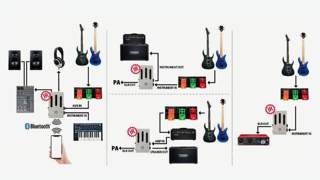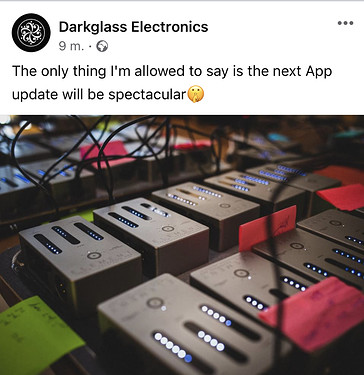Ooooh. That’s high praise!
Heh, yes. Well, I can’t hear much difference, put it that way. But, then again, I have the hearing and tinnitus of a mid-50s aged rock drummer …
Yep that’s one way to do it. Need to be careful with phase issues that way though.
Ugh. I have to come clean on something.
Darkglass did respond to my emails. The problem was on my end. GMail had pushed them off to the spam folder and I missed them. That problem is corrected now.
I sent this…
Hello People of Darkglass! Can the Element take a line level or mic level signal through the instrument IN?
Thank you,
Eric Kiser
Here is the response…
Hi Eric, I hope you are well,
Yes, you can, in fact, the Element is fully compatible with guitars, bass, keyboards, or any kind of electric instrument!
Few days ago, I recorded some voices in my home studio and it works perfectly well.
I attach an image with different types of usability of the Element.
Hope this information helps you and please let me know if there’s anything else I can assist you with.
Best regards, Erik,
Erik Fuenzalida
Darkglass Electronics
Here is the picture he sent…

So the ins can be outs too? That thing is snazzy!
Yeah. It makes the idea of having two headphone outs make a lot more sense.
I sent a bunch more questions and I’ll update based on what they say.
I did find it surprising that they weren’t originally responding, I always found their customer service to be great.
Yep. I’m going to add notes and correction to my original post as I get more information.
Now that is just a dirty tease.
Drum machine, coffee maker and TV remote control.
Small processor running the NeuralDSP Darkglass Ultra plugin 
It would instantly become the best selling Darkglass pedal.
LoL!
When I read this the only thing I could think about was there would still be someone out there that would get an Element and say, “Yeah. I got one. I guess it was alright. If you like Darkglass. Not my thing though” 
 I’m guessing a noise gate. Kinda hoping on the other ones that are suggested!
I’m guessing a noise gate. Kinda hoping on the other ones that are suggested!
Erik Fuenzalida, that answered my last questions said I could send any other questions I had directly to him.
And… I did. 

I don’t think this poor guy realized the can of worms he was opening when he made that offer.
In retrospect, I probably shouldn’t have slammed him with everything all at once.
I just heard back from Darkglass…
- The Element can NOT be powered from USB. I don’t have a very good understanding of what the capabilities are for the Element. Is this something that could be added, with a software change, in the future?
No, the Element was designed and conceived as a pedal, therefore you will always need a power supply (higher than the energy charge of a smartphone)
- This picture makes it appear as though you can use both the Instrument IN and the Instrument OUT for a second Instrument IN. Is this correct?
Only if you connect your bass or guitar (or any electric instrument) to the Aux-in.
- I have read that when you record through the DAI, the Element creates two tracks. If you have two instruments going in, does each one get its own track, or are they combined?
You can record only one instrument at a time, the tracks will always be from the same instrument.
- Can the AUX IN handle a full Line Level signal or is it designed for consumer-grade line out, like from a laptop?
The aux in has been designed to accept max. 1Vrms (0dBV / +2dBu) signals.
- Do the Headphone OUTS put out a full Line Level signal or are those consumer-grade, once again, like a laptop?
Headphone outputs can output up to 2.8Vrms (9dBV / 11dBu) signals.
- Can you point me to any documentation on the Tuner feature? I found out how to turn it on/off but how do you know what note you’re tuning to? How accurate is it? That kind of stuff.
It is a super precise tuner, and tunes according to the string you need to tune.
- I want to record from an older Vox 15, a 15-watt tube amp, it only has two OUTs. One bypasses the speaker to go to a separate cabinet. The other uses the speaker and lets you add a cabinet. How do I connect this to make sure I don’t set anything on fire?
I am attaching a photo that shows the different types of usability of the Element.
- I read a rumor that Darkglass is working on a drum machine of some kind to add to the Element. Is this a real thing?
We are already working on a noise gate and a metronome.
![]()
I just read that the Element’s DAI is only 48kHz sampling rate. That would be a show-stopper for me as a primary audio interface. 24-bit/96kHz is the standard for high quality interfaces and there’s good reasons for this. I would not consider less than that for my primary audio interface.
Can you talk about why that’s a big deal?
Two reasons.
CD quality audio is 16-bit/44.1kHz. The minimum sampling rate to avoid aliasing is therefore 88.2kHz.
Now, this aliasing is a tiny effect and people would not be able to hear the difference as it is (most likely anyway). But why not just avoid the issue altogether with an adequate sampling rate?
- Aliasing artifacts - Mixing and Mastering at 96kHz — Ryan Schwabe. Again, Nyquist.
Even though we can’t hear higher than 20kHz, higher frequency harmonics can clip due to sampling rate and fold back down to lower harmonics that we can hear.
There’s a neat audio link at the end of that blog article that shows you the phase-inverted difference between a 96kHz file and a 44.1kHz file. It’s more than you might think.
In general - you always want the highest possible sampling rate.
So tl;dr, for just recording occasional covers, 48kHz is fine. If you want to record music for production, it is not.
